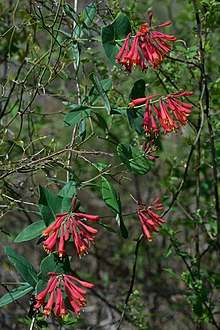Lonicera sempervirens
| Lonicera sempervirens | |
|---|---|
 | |
| Scientific classification | |
| Kingdom: | Plantae |
| Clade: | Angiosperms |
| Clade: | Eudicots |
| Clade: | Asterids |
| Order: | Dipsacales |
| Family: | Caprifoliaceae |
| Genus: | Lonicera |
| Species: | L. sempervirens |
| Binomial name | |
| Lonicera sempervirens | |
Lonicera sempervirens (commonly known as coral honeysuckle, trumpet honeysuckle, or scarlet honeysuckle) is a species of honeysuckle native to the eastern United States.[1][2]
It can grow in many areas due to its hardiness.[3] It is most often grown as a plant for wildlife. Ruby-throated hummingbirds use it in their natural range[4] as well as other birds, butterflies, and bees.[5] It is also grown as an ornamental for its attractive flowers, especially as a native alternative to the invasive Japanese honeysuckle.[6][7] Several cultivars have been selected for variation in flower color, including 'Magnifica' (flowers red outside, yellow inside), 'Sulphurea' (yellow flowers), and 'Superba' (bright scarlet flowers).[8]
It is a twining vine growing to 20 ft or more through shrubs and young trees. The leaves are produced in opposite pairs, oval, up to 5 cm long and 4 cm broad; the leaves immediately below the flowers are perfoliate, joined at the base in a complete ring round the shoot. They are evergreen in zone 8 and warmer and deciduous in colder climates. This is the reason for the species epithet, from Latin sempervirens, meaning "evergreen".[9] The flowers are produced on new growth in clusters of several groups of three together, tubular, 5 cm long, with five small lobes opening at the tip to expose the stamens and stigma. Ruby-throated hummingbirds and insects pollinate the bright red to pinkish-red flowers from mid-spring to fall.[10][4]
Gallery
| Wikimedia Commons has media related to Lonicera sempervirens. |
_RWD4.jpg) Ruby-throated hummingbird feeding
Ruby-throated hummingbird feeding Flower buds
Flower buds Leaves and appearance after blooms detach
Leaves and appearance after blooms detach- Close-up of blooms
 Pinkish-red flowers with yellow insides
Pinkish-red flowers with yellow insides
References
- ↑ "Lonicera sempervirens". Natural Resources Conservation Service PLANTS Database. USDA.
- ↑ "Lonicera sempervirens". County-level distribution map from the North American Plant Atlas (NAPA). Biota of North America Program (BONAP). 2014.
- ↑ Gilman, Edward F. (2015-08-14). "Lonicera sempervirens Trumpet Honeysuckle". edis.ifas.ufl.edu. Retrieved 2017-06-30.
- 1 2 Operation Rubythroat "Top Ten" Native Hummingbird Plants: Lonicera sempervirens
- ↑ "Lonicera sempervirens". plants.ces.ncsu.edu. Retrieved 2017-06-30.
- ↑ RHS A-Z encyclopedia of garden plants. United Kingdom: Dorling Kindersley. 2008. p. 1136. ISBN 1405332964.
- ↑ "RHS Plant Selector - Lonicera sempervirens". Retrieved 26 June 2013.
- ↑ Huxley, A., ed. (1992). New RHS Dictionary of Gardening. Macmillan ISBN 0-333-47494-5.
- ↑ Harrison, Lorraine (2012). RHS Latin for gardeners. United Kingdom: Mitchell Beazley. p. 224. ISBN 9781845337315.
- ↑ Tenaglia, Dan. "Lonicera sempervirens page". Missouri Plants. Missouri Botanical Garden.